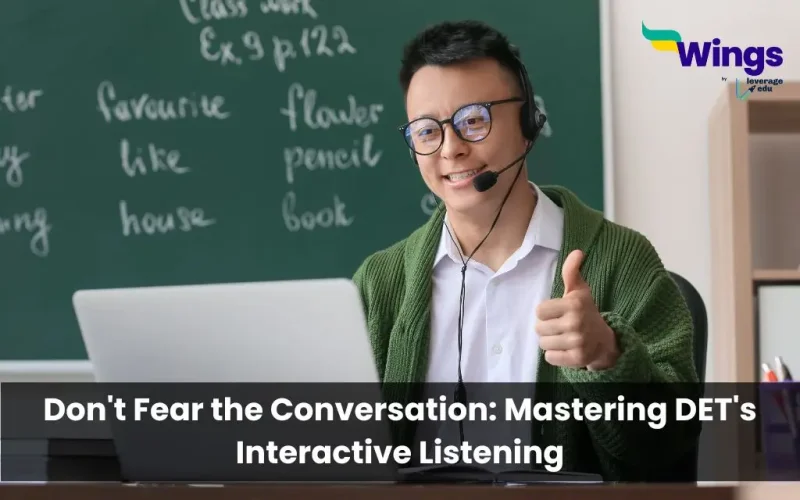DET Interactive Listening Tips: The Duolingo English Test (DET) is an English test designed for you—convenient, fast, affordable, and trusted worldwide. At the core of the (DET) lies innovation addressing the evolving needs, experiences, and interactions of budding learners. The Duolingo English Test (DET) introduced a groundbreaking feature last year called Interactive Listening. The inclusion of Interactive Listening in the test introduces fresh and creative methods of evaluating proficiency skills beyond traditional academic contexts. Interactive Listening is a multi-step question type that will contribute to the overall score as well as all four subscores. The DET is also recognized by 5000+ universities in over 50 countries and is commonly accepted for admissions, placement, progress, or exit requirements.
This Blog Includes:
What is the Interactive Listening Question Type?
This new question type immerses test-takers in simulated conversations with AI characters to measure proficiency skills needed for university settings. It simulates both student-to-student and student-and-professor interactions, preparing students for academic success.
The DET’s Interactive Listening section includes two scenarios, each with two parts. Below, you’ll find the question types you can expect in Interactive Listening, along with tips on how to approach this section.
Enhance Your Conversational Skills with Listen and Respond
Developing strong communication skills is crucial for success in both academic and professional settings. The Listen and Respond question type entails selecting the most appropriate option to initiate a conversation. In this question format, test takers are presented with an animated conversational partner represented by one of the Duolingo characters. The candidate receives a brief description of a common scenario that a university student might encounter. Subsequently, the test taker participates in a multi-turn conversation to achieve specific communication goals, such as seeking further information from a professor about a class topic or asking a friend to review a paper. Each Interactive Listening scenario includes approximately 5-6 Listen and Respond questions, with a 4-minute time limit for completion.
You can follow these tips to ace the “Listen & Respond” section:
- Interacting with the question
- Stay alert! The audio clips can only be played once, so try and find keywords in the audio.
- If necessary, you can refer back to the earlier parts of the conversation for assistance.
- Responding to the question
- Consider the relationship between the speakers. How would two students talk to each other? How would a teacher and a student communicate in a professional setting?
- Don’t stress about choosing the accurate response — the test will give you feedback with explanations, allowing you to improve your subsequent answers. Pay attention to where you went wrong to understand the nature of the conversation.
- Try to retain the key points of the conversation for the subsequent summary task.
Summarize the Conversation
This part of the evaluation focuses on your ability to comprehend and summarize conversations. You’ll be presented with an interactive listening scenario. After engaging in a conversation, you’ll have 75 seconds to summarize the key points. This question will appear once for each Interactive Listening scenario, requiring you to write a brief summary of the Listen and Respond conversation.
Here are some tips to keep in mind to “Summarize the Conversation”:
- Interacting with the question
- If you didn’t select the most optimal answers in the preceding section, there’s no need to worry. Rather, concentrate on summarizing the conversation.
- Write a paragraph in continuity instead of providing separate bullet points.
- In the limited time that you have to answer, it’s highly recommended the 5 W’s strategy to highlight the key details of the conversation. Who were the speakers? What was the conversation about? When did the conversation take place? Why did the conversation occur? What was the result or outcome?
- Not all the questions will be relevant for every scenario, so choose wisely. For example, the setting of the conversation is not always clear.
- Utilise the entire time available to write a detailed summary. If time permits, review your response for spelling and grammar accuracy.
The Duolingo English Test (DET) has a total duration of one hour. The various question types contribute to the overall score by assessing multiple language skills simultaneously, reflecting how these skills are used in real-life scenarios. By listening to and responding to a conversation partner, test takers showcase their comprehension and conversation abilities. Writing a summary of the conversation afterwards demonstrates literacy and production skills. Specifically, the listening component affects the conversation and comprehension subscores, while the summarization segment influences the production and literacy subscores.
FAQs
Ans: The Interactive Listening Section is a new format on the DET that assesses your ability to participate in simulated conversations. It presents you with scenarios involving university life, like asking a professor a question or requesting help from a classmate. You’ll listen to short audio clips and choose the best response to initiate or continue the conversation.
Ans: Absolutely! Reading the scenario first gives you important context like who you’re talking to and the conversation. With that background information, you’ll be able to choose the best response in the audio clip.
Don’t panic! Often, you can understand the meaning without every single word. Focus on keywords and phrases that give you clues about the conversation’s direction.
Visit the Leverage Live page of Leverage edu or contact our study abroad experts at 1800-57-2000 to strengthen your scores and application to secure your spot in your dream college.
 One app for all your study abroad needs
One app for all your study abroad needs















 60,000+ students trusted us with their dreams. Take the first step today!
60,000+ students trusted us with their dreams. Take the first step today!